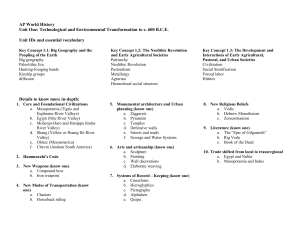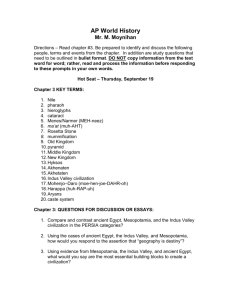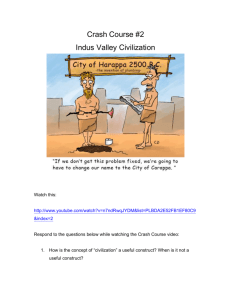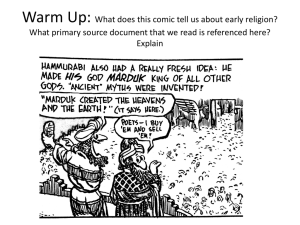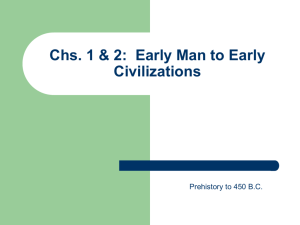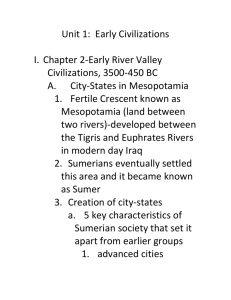Ch 2 River Civ 2
advertisement
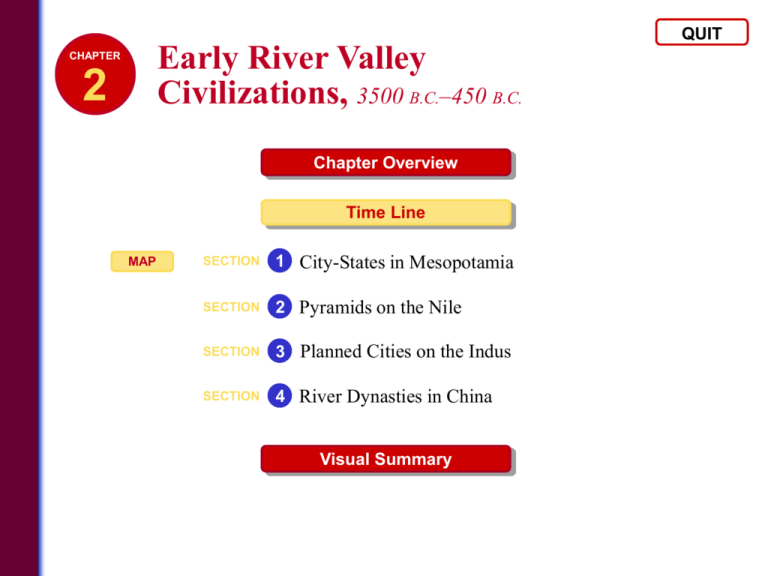
Early River Valley Civilizations, 3500 B.C.–450 B.C. CHAPTER 2 Chapter Overview Time Line MAP SECTION 1 City-States in Mesopotamia SECTION 2 Pyramids on the Nile SECTION 3 Planned Cities on the Indus SECTION 4 River Dynasties in China Visual Summary QUIT CHAPTER 2 Early River Valley Civilizations, 3500 B.C.–450 B.C. Chapter Overview The river valley civilizations develop from small farming villages. The civilizations create laws, centralized governments, writing systems, and advanced technologies. The process of trade spreads new ideas to and from these civilizations. HOME CHAPTER 2 Early River Valley Civilizations, 3500 B.C.–450 B.C. HOME Time Line 3000 B.C. City-states form in Sumer, Mesopotamia. 1792 B.C. Hammurabi develops code of laws for Babylonian Empire. 1027 B.C. Zhou dynasty forms in China. 3500 B.C. 450 B.C. 2660 B.C. Egypt’s Old Kingdom develops. 1550 B.C. Indus Valley civilization declines. 1 HOME City-States in Mesopotamia MAP Key Idea Working together to overcome environmental challenges leads to the development of centralized government and cities in Mesopotamia. The Sumerian civilization influences later civilizations. Overview Assessment 1 HOME City-States in Mesopotamia MAP TERMS & NAMES Overview • Fertile Crescent • silt MAIN IDEA WHY IT MATTERS NOW • irrigation The earliest civilization in Asia arose in Mesopotamia and organized into city-states. The development of this civilization reflects a pattern that has occurred repeatedly throughout history. • city-state • dynasty • cultural diffusion • polytheism • empire • Hammurabi Assessment 1 HOME City-States in Mesopotamia MAP Section 1 Assessment 1. Look at the graphic to help organize your thoughts. List three environmental challenges the Sumerians faced and their solutions to these challenges. Challenges Solution unpredictable flooding irrigation defenselessness walled cities limited resources trade continued . . . 1 HOME City-States in Mesopotamia MAP Section 1 Assessment 2. What advantages did living in cities offer the people of ancient Mesopotamia? Do modern cities offer any of the same advantages? THINK ABOUT • characteristics of Sumer’s city-states • characteristics of Sumer’s economy and society • development of organized government ANSWER Possible Responses: Opportunity for wealth; diversity of work available; government that promotes laws, manages economy, and provides assistance; better housing; city walls and armies for protection; proximity to temple; more social contact. Cities today offer many of these advantages. continued . . . 1 HOME City-States in Mesopotamia MAP Section 1 Assessment 3. Do you think that living in a river valley with little rainfall helped or hurt the development of civilization in Mesopotamia? Explain your response. ANSWER Possible Response: It helped, because the Sumerians had to develop the technology and organization to get water to the fields. This led to the development of organized government. End of Section 1 2 HOME Pyramids on the Nile Key Idea Egyptian civilization develops along the Nile River. Upper and lower Egypt are united into a kingdom and ruled by pharaohs, who are believed to be gods. Egyptian customs for preparing and burying the bodies of the dead include mummification and burying pharaohs in pyramids. Overview Assessment 2 HOME Pyramids on the Nile TERMS & NAMES Overview • cataract • delta MAIN IDEA WHY IT MATTERS NOW • Menes Along the Nile River, civilization emerged in Egypt and became united into a kingdom ruled by pharaohs. Many of the monuments built by the Egyptians stand as a testament to their ancient civilization. • pharaoh • theocracy • pyramid • mummification • hieroglyphics • papyrus Assessment 2 HOME Pyramids on the Nile Section 2 Assessment 1. Look at the graphic to help organize your thoughts. Give four examples of Egyptian achievements. Mummification Pyramids Hieroglyphics Egyptian Achievements Advances in medicine Calendar Written numbers continued . . . 2 HOME Pyramids on the Nile Section 2 Assessment 2. Three natural features determined the boundaries of ancient Egyptian civilization: the Nile River, the First Cataract, and the surrounding desert. In your judgment, which of these features was most important to Egypt’s history? ANSWER Possible Responses: • The Nile River—it provided fertile soil, a predictable growing season, and easy transportation within Egypt. • The First Cataract—it presented an obstacle to trade and communication with peoples on the upper Nile. • The deserts—they limited outside contact but also prevented invasions. End of Section 2 3 HOME Planned Cities on the Indus Key Idea The Indus Valley people build planned cities with sophisticated sewage and plumbing systems. Archaeological evidence suggests the Indus civilization is stable and prosperous. Indus Valley culture ends mysteriously. Overview Assessment 3 HOME Planned Cities on the Indus TERMS & NAMES Overview • subcontinent • monsoon MAIN IDEA WHY IT MATTERS NOW The first Indian civilization built wellplanned cities on the banks of the Indus River. The culture of India today has its roots in the civilization of the early Indus cities. Assessment 3 HOME Planned Cities on the Indus Section 3 Assessment 1. Look at the graphic to help organize your thoughts. List the environmental conditions faced by the people of the Indus Valley. For each one, explain whether the condition was a benefit or a drawback. Environmental Condition monsoons floods Benefit or Drawback (-) too little rain (-) too much rain (+) spread deposits of rich soil over wide area (-) unpredictable high mountains (+) natural barrier helped protect against invasion large desert (+) natural barrier helped protect against invasion continued . . . 3 HOME Planned Cities on the Indus Section 3 Assessment 2. What evidence has led historians to the following beliefs about Indus civilization? (a) The cities were run by a strong central government. (b) Indus people carried on trade with Sumer. (c) Society was generally peaceful and stable. ANSWER (a) Planned cities, uniform buildings, sanitation systems (b) Indus seals found in Mesopotamia (c) Uniform housing, children’s toys, few weapons End of Section 3 4 HOME River Dynasties in China Key Idea Ancient Chinese civilization is ruled by powerful family dynasties. Just rulers are believed to have divine approval. In Chinese culture, family is central to society and religion. Improvements are made in technology and trade. Feudalism is established. Overview Assessment 4 HOME River Dynasties in China TERMS & NAMES Overview • loess • oracle bone MAIN IDEA WHY IT MATTERS NOW • Mandate of Heaven The early rulers introduced ideas about government and society that shaped Chinese civilization. The culture that took root during ancient times still affects Chinese ways of life today. • dynastic cycle Assessment • feudalism 4 HOME River Dynasties in China Section 4 Assessment 1. Look at the graphic to help organize your thoughts. List the major developments in the early Chinese dynasties. Event One Xia is the first Chinese dynasty. Event Three Shang develop writing. Event Two Shang develop first cities. Event Five Zhou are first to control by feudalism. Event Four Zhou claim Mandate of Heaven. continued . . . 4 HOME River Dynasties in China Section 4 Assessment 2. The group was often more important than the individual in Chinese culture. In your judgment, what are the benefits and drawbacks of this belief? THINK ABOUT • family roles • the characteristics of a ruler • role of spirit gods ANSWER Possible Responses: • Benefits—family cares for elderly, less government money spent on social programs, respect for deceased family members/gods • Drawbacks—less time for individuals to pursue interests, difficult to break away when family or ruler is unjust continued . . . 4 HOME River Dynasties in China Section 4 Assessment 3. Do you think that the Zhou Dynasty’s downfall resulted because of their method of control? Why or why not? THINK ABOUT • feudalism • the large division of rich and poor • the vast controlled lands • the noble-king relationship ANSWER Possible Responses: • Yes—great distance between ruler and ruled, lords were greedy, chaotic warfare • No—the Zhou ruled successfully for 300 years. Their downfall wasn’t because of feudalism but because invaders killed the backbone of the dynasty, the Zhou monarchy. End of Section 4

